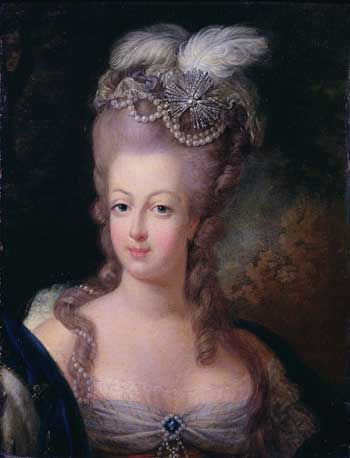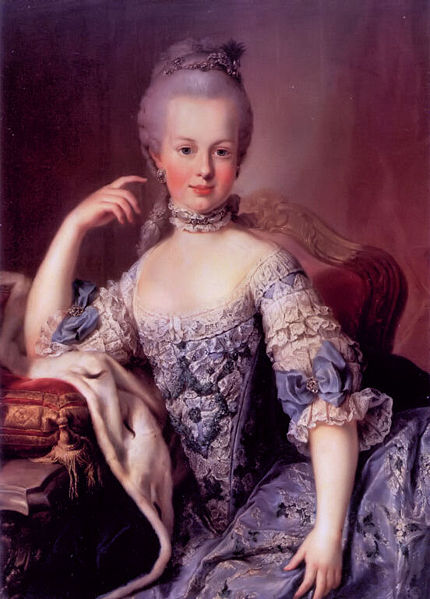Of Marie Antoinette it is said she was queen who danced while her people starved; who bought fineries and exorbitantly expensive jewels while France's subjects died from famine. Yet those who defend her say she was only a young girl, raised for that kind of life and who wasn't even aware of what was happening outside de palace gates.Such is the widespread view of Marie Antoinette, Queen of France , wife of King Louis XVI.
A summary of Marie Antoinette's life (1755-1793) could be the following: a beautiful queen who became an icon of the extravagant and lustful 18th century monarchy, who was stripped of her wealth and possessions, imprisoned and later beheaded by the people of France soon after the French Revolution began in 1789.
Marie Antoinette's life makes a rather interesting read. When the young queen-to-be was born, no one could have foreseen the violent end of her life and her many misfortunes. Marie Antoinette was born in 1755 at very top of the European aristocracy.

Marie Antoinette was the 15th daughter of the Empress of Austria, Maria Teresa. The young French queen herself was born to the privileges of being a princess and and archduchess. It is said that Maria Teresa had many talents, and one of the was the astute and cunning way in which she married her children, all of them with strategic purpose. Marie Antoinette was no difference. For Maria Teresa's alleged favorite daughter, a very pretty girl, the Empress chose no other than the French King, which would secure the alliance between their two nations.
Marie Antoinette was married at 14 to the future King of France. At first, hers was a dream life. France was among the most powerful nations of the world, certainly the strongest in Europe. The young couple lived in the Palace of Versailles, indisputably the most sumptuous.
The life of Marie Antoinette was the stuff of dreams and her fairy tale like life reached its zenith then her husband became King Louis XVI in 1774, she was only 19 years old.
Louis was not exactly the ideal husband for someone like Marie Antoinette; unattractive and awkward. Allegedly more devoted to hunt and clocks, his life style clashed entirely with the young queen's, who loved the arts, fashion, dance and nightlife in general. She was a reputed beauty, however her own husband took seven years consummate the marriage. She was pressured by the Courts to produce an heir, something quite difficult to do without your husband's participation.
Not long after Marie Antoinette became increasingly bored with her marriage, as it was deeply unsatisfactory for her. Her days were spent in never ending court ceremonies and and punctilious etiquette, dating back to the times of Louis XIV. She began spending less and less time at court and more time with her young friends.
Marie Antoinette's life became one of pleasure and lavishness. Balls in Paris, gambling, theatre and late night walks in the park become some of her favorite and frequent activities.
Marie had a Viennese like retreat built in the palace (the hameau). She enjoyed pretending to be milkmaid while playing with perfumed farm animals, mainly sheep and goats.
The young queen was soon setting fashion trends through France and Europe but this came at a price. Each year she exceeded her clothing allowance with increasingly extravagant dresses, taller head pieces and bigger feathers. Her style was emulated by wealthy aristocrats all over the continent, but the expense didn't go unnoticed.

By the late 1780s, envy and hatred of Marie Antoinette had spread like fire in a hay field. Stories of the queen’s extravagance, dissipation and sexual vice circulated, many of them spread by members of the nobility who were repulsed by her "vices". In 1784 the Diamond Necklace Affair became the sensation, grabbing the attention of the entire nation.
It concerned a diamond necklace commissioned from Parisian jewelers Boehmer & Bassenge by Louis XV for his mistress Madame du Barry. It took several years to make so by the time the necklace was finished Louis XV had died. The jewelers needed to sell it to avoid bankruptcy. They offered the necklace to the new queen, Marie Antoinette, but she refused. So, in enters a con artist and a well-placed pawn.
Jeanne de Saint-Remy de Valois, comtesse de la Motte, a notorious con-woman, who slept her way to the top of the social pyramid while claiming to be an aristocrat. She became the mistress of a former French ambassador who was anxious to regain the Queen's favor, Cardinal de Rohan.
Jeanne persuaded her lover that she was a confidante of the Queen and that she could arrange a meeting so Rohan and Mary Antoinette could reconcile. Rohan began writing to the queen and she replied, or that's what he thought, as it was Jeanne herself who forged her letters. Jeanne was a cunning woman and she even dressed up a prostitute as Maria Antoinette, making Rohan believe that she had fulfilled her word.
An unsuspecting and in love Rohan was persuaded by his lover that the queen loved Boehmer's diamond necklace but she couldn't really allow herself to spend such an extravagant amount. Rohan decided to buy the necklace in Mary Antoinette's place and gave it to one of the queen's footmen who promised to give it to her majesty. Of course, the "footman" was Jeanne's husband.
Needless to say, the ridiculously expensive necklace went missing (it was later reported that it somehow reached London, where it was finally sold). When the real Marie Antoinette received an enormous bill...well, it became a public scandal. The Cardinal was accused, his lover and artifice of the whole affair was arrested along with many other people who happened to be unlucky enough to have met Rohan.
A sensational trial followed and the cardinal was used as an scapegoat, it was really an excuse to attack Queen and destroy her reputation. Despite the proof many people believed, or chose to believe that Marie Antoinette had used Jeanne to exact a petty revenge. Some historians claim that the diamond necklace affair was one of the many straws that broke the camel's back, or at least, it was a factor that contributed to the discontent of the subjects of the French crown, which ended up in the French Revolution.